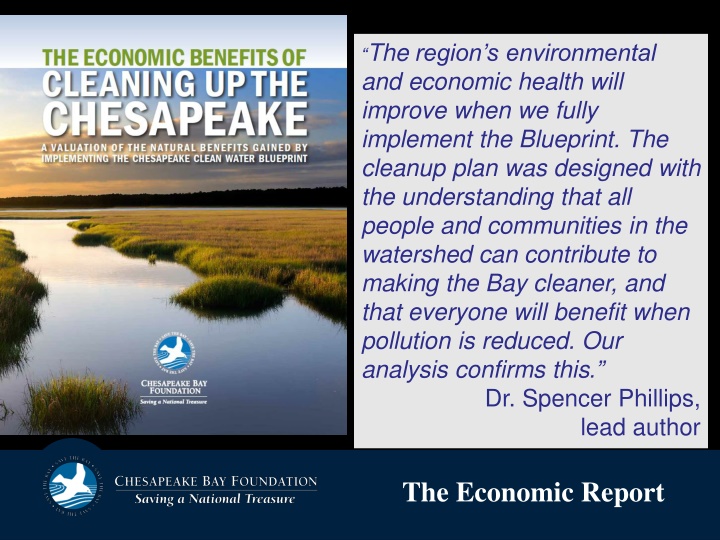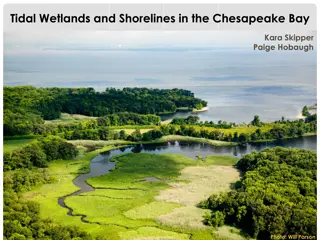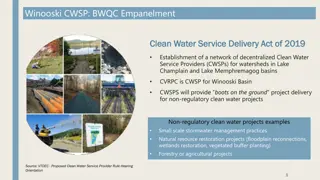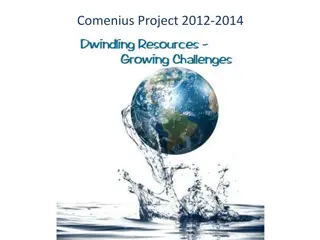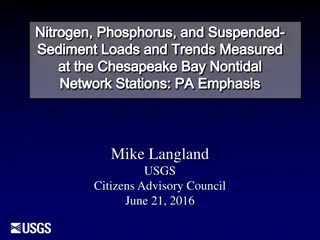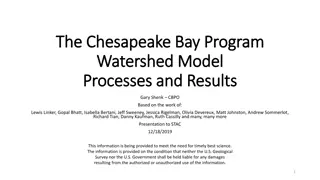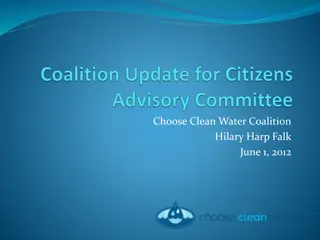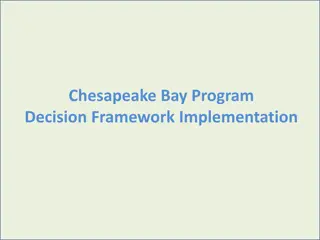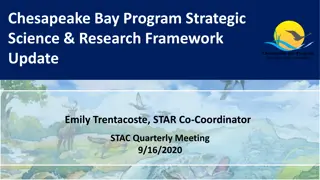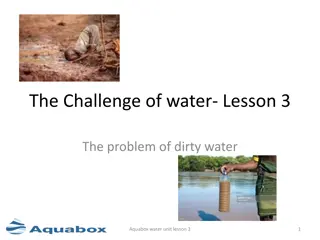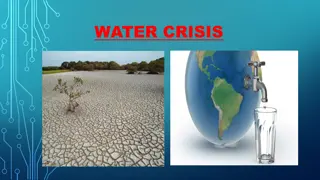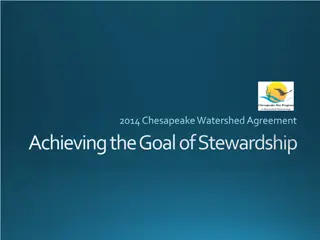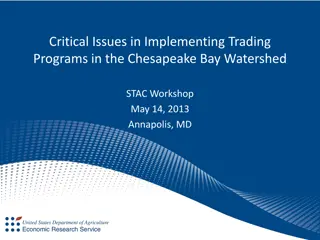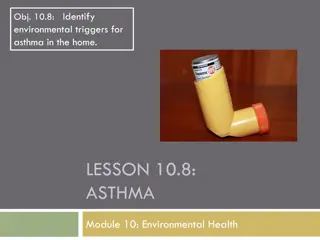Economic Benefits of Chesapeake Clean Water Blueprint
In efforts to improve the environmental and economic health of the region, the Chesapeake Clean Water Blueprint aims to reduce pollution in the watershed. By fully implementing the blueprint, various ecosystem services will be positively impacted, leading to benefits like waste treatment cost reductions, improved water supply, enhanced recreation opportunities, and more. The study highlights the significance of ecosystem services provided by the Bay and its watershed, emphasizing the need for collective action for a cleaner and healthier environment.
Download Presentation

Please find below an Image/Link to download the presentation.
The content on the website is provided AS IS for your information and personal use only. It may not be sold, licensed, or shared on other websites without obtaining consent from the author.If you encounter any issues during the download, it is possible that the publisher has removed the file from their server.
You are allowed to download the files provided on this website for personal or commercial use, subject to the condition that they are used lawfully. All files are the property of their respective owners.
The content on the website is provided AS IS for your information and personal use only. It may not be sold, licensed, or shared on other websites without obtaining consent from the author.
E N D
Presentation Transcript
The regions environmental and economic health will improve when we fully implement the Blueprint. The cleanup plan was designed with the understanding that all people and communities in the watershed can contribute to making the Bay cleaner, and that everyone will benefit when pollution is reduced. Our analysis confirms this. Dr. Spencer Phillips, lead author Title Text for Slide The Economic Report
Outline What are ecosystem services? What types of ecosystem services does the Bay and its watershed provide? How will the Chesapeake Clean Water Blueprint affect them? Study results
Ecosystem Services Our lands, waters, and associated plants and animals provide natural benefits that economists call ecosystem services. These benefits include production of goods such as food and timber; life-supporting processes such as water and air purification and flood protection; and life-enhancing assets such as beautiful places to recreate and live.
Three Scenarios The present-day dollar value of natural benefits for the watershed (based on 2009 pre-Blueprint) The dollar value of the same services post-Blueprint Estimate of what we lose if we don t fully implement the Blueprint ( Business as usual )
We chose 8 natural benefits that are most likely to be affected by the Blueprint: Waste Treatment Reduced treatment facility costs, (less to filter) Water Supply Reduced flood damage Water regulation Recreation Eco-tourism, fishing trips, hiking Improved soil health and yield (drought resistance), more fish and shellfish Reduced energy costs due to moderated urban temperatures Reduction in asthma cases and other public health benefits Increased property values Food Production Climate Stability Air Pollution Trt Aesthetics Examples
Approach Worked with CBP staff to acquire fine scale land use information for entire watershed for the three scenarios
Examples of natural benefits by land use Agriculture Aesthetic value, food production Forests (including buffers) Air pollution treatment, water supply Open Water Recreation, food production Climate stability, waste treatment Urban Open (parks, etc.) Water regulation Urban (impervious) Water regulation, waste treatment Wetland Recreation Other Ecosystem Services
Implementation of Blueprint will have 2 primary effects: 1. Changes in acres of the various habitats e.g., increases in higher value habitats like forests 2. Improved condition of existing habitats and their services (e.g., increased Bay DO results in more food production, reduced nitrogen pollution means healthier wetlands that can better reduce flooding) Approach
Present-day Benefits $107 billion annually spread across entire watershed
Business as Usual Without Blueprint: benefits decline to $101.5 billion annually a loss of $5.6B
Post-Blueprint $22 billion in annual benefits
Baseline Blueprint Business-as-Usual Change from Baseline Value (millions of 2013$) Value (millions of 2013$) Value (millions of 2013$) Change from Baseline Jurisdiction 8,346 -3,189 41,195 49,540 38,006 Virginia 6,191 -1,827 32,637 38,828 30,810 Pennsylvania 4,557 -683 15,892 20,449 15,209 Maryland 1,915 1.5 10,361 12,276 10,363 New York 1,338 128 6,330 7,668 6,458 West Virginia 206 -76 735 941 659 Delaware 3.8 1.2 25 29 27 District of Columbia Total $129,732 $ 22,556 - $5,645 $107,176 $101,531
Takeaways Watershed-wide benefits Benefits 4x the cost
THANK YOU QUESTIONS? The End
Baseline Scenario 2009 land use Adjust values of current condition (Baseline) based on a measure of human impact and degradation ( Index of Wildness , Tidal DO). Approach
Blueprint Scenario 2025 Projected land use w/Blueprint Upstream improvement in habitat based on expected pollution reductions in sediment, nitrogen, and phosphorus Tidal water improvement based on expected improvements in dissolved oxygen
BAU Scenario 2025 Projected landuse no Blueprint Upstream degradation in habitat based on expected pollution increases in sediment, nitrogen, and phosphorus in 2025 according to CBP projections Tidal water dissolved oxygen assumed to be the same as 2009
Baseline (2009) Blueprint Business as Usual Tidal Segments (Health Indicator, 0-1 scale) 0.709 1.000 0.709 Open Water (Acres) 2,902,290 2,902,290 2,902,290 Non-Tidal Segments (Health Indicator, 0-1 scale) 0.533 0.606 0.494 Agriculture (Acres) 9,115,604 8,508,590 8,937,770 Forest (Acres) 26,087,310 26,146,565 25,599,783 Open Water (Acres) 418,638 418,638 418,638 Urban Open (Acres) 1,827,581 2,138,186 2,157,705 Urban Other (Acres) 3,272,272 3,519,108 3,627,798 Wetland (Acres) 245,895 238,374 232,321 Other (Acres) 130,960 128,794 124,252
Ecosystem Service Value (ESV) Land use adjusted for quality (acre-1) x Ecosystem Service Value(land use type) ($ acre-1 year-1) = Economic value ($ year-1) Total Value
Baseline Blueprint Business-as-Usual ESV ESV Change from Baseline (%) Difference from BAU (%) ESV Change from Baseline (%) Land Use (millions of 2013$) (millions of 2013$) (millions of 2013$) 12,258 13,434 10% 23% 10,949 -11% Agriculture 73,960 86,406 17% 24% 69,639 -6% Forest 16,721 24,301 45% 47% 16,549 -1% Open Water 3,403 4,706 38% 26% 3,727 10% Urban Open 11 14 26% 18% 12 7% Urban Other 356 364 2% 34% 270 -24% Wetland 467 508 9% 32% 386 -17% Other $107,176 $129,732 21% 28% $101,531 -5% Total
